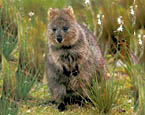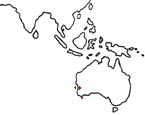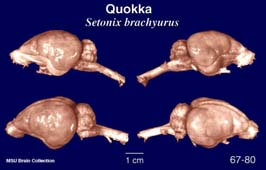|
Quokka
Setonix brachyurus
The head and body length of S. brachyurus is from 475-600 mm,
tail length is 250-350 mm. Adults weigh between 2 and 5 kg.
Coloration of the short, coarse fur is generally brownish gray,
and sometimes tinged with rufous. S. brachyurus has no
distinct markings. The ears are short and round and the tail
is sparsely furred and short. Females have four mammae and a
well developed pouch.
S. brachyurus living on the mainland of Australia are
confined to dense vegetation in swamps within dry sclerophyll
forest, while on the Rottnest and Bald Islands S. brachyurus
inhabits a variety of environments. Quokka are herbivorous,
emerging from shelters to feed on a variety of plants.
Females are polyestrous with cycles averaging 28 days and gestation
ranging from 26-28 days. Only one young is able to be reared
each year, and litter size therefore is generally one. The female
mates the day after her baby is born. Embryonic diapause, first
demonstrated in Setonix, occurs and if the baby in the mother’s
pouch dies, the embryo resumes development and is delivered
24-27 days later. If the first baby is successfully reared,
the embryo degenerates when the mother enters anestrous. Young
leave the mother’s pouch at 175 - 195 days, but will continue
to suckle another 3-4 months. Sexual maturity has been recorded
at 389 days in males and 252 days in females.
Quokka populations are under stress throughout their range due
to development and are listed as endangered by the USDI. They
are found in SW Western Australia, including Rottnest Island
and Bald Island (Australia).
|



